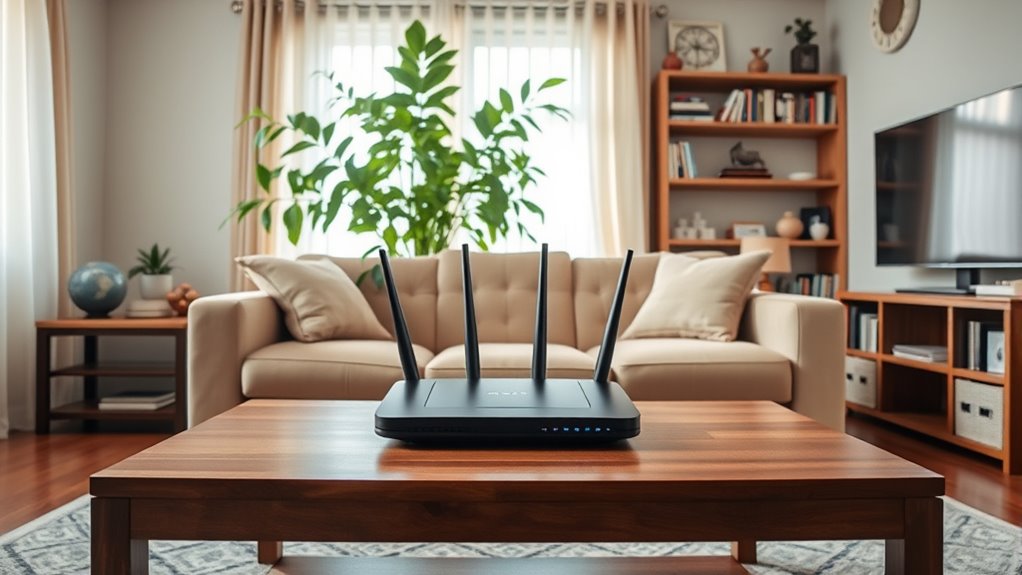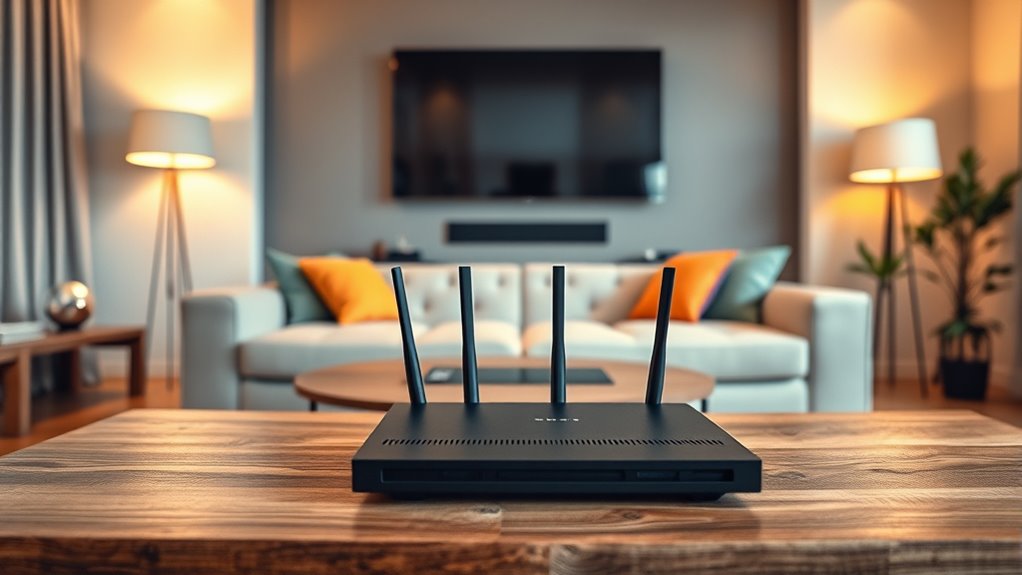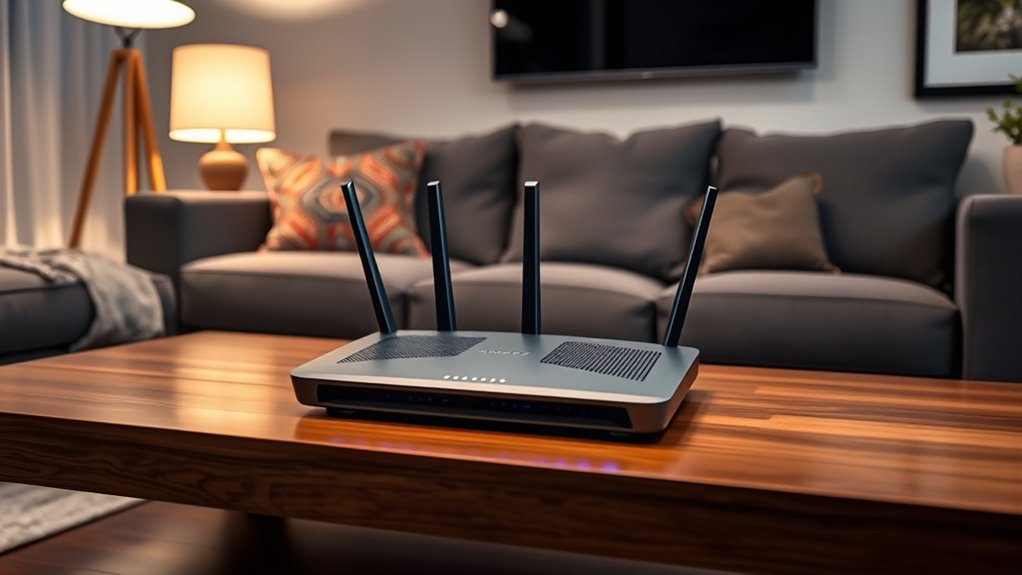Placing your router in the living room guarantees strong, even Wi-Fi coverage throughout your home by reducing dead zones and interference. It keeps the signal centralized, making device connections more reliable and your network easier to manage. Proper placement also enhances security and smart home integration. Avoid hiding it behind furniture or in corners—performance drops when signals are blocked. Keep exploring how ideal placement boosts your home network’s security and efficiency.
Key Takeaways
- Central placement in the living room ensures even Wi-Fi coverage and minimizes dead zones throughout the home.
- Positioning the router openly reduces signal interference from furniture, appliances, and walls.
- Easy access in the living room simplifies device management, troubleshooting, and firmware updates.
- High, visible placement enhances physical security and deters tampering or unauthorized access.
- Integrating the router into the living room supports smart home device connectivity and overall network reliability.
The Impact of Router Placement on Signal Strength

The placement of your router directly affects the strength and quality of your Wi-Fi signal. If you position it near interference sources like microwaves, cordless phones, or thick walls, you’ll experience signal attenuation, which weakens your connection. Avoid hiding your router in closets or behind furniture, as obstructions can block or diminish the signal. Placing it higher, on a central shelf or wall, helps distribute Wi-Fi evenly throughout your space. Keep it away from metal objects and electronics that emit electromagnetic interference, which can disrupt signal clarity. Additionally, selecting the appropriate headphone jack when connecting audio devices can help ensure optimal sound quality. By optimizing your router’s location, you reduce interference sources and minimize signal attenuation, ensuring a stronger, more reliable Wi-Fi connection across your living space.
Benefits of Centralized Wi-Fi Coverage in the Living Room

Having centralized Wi-Fi in your living room boosts signal strength, so your devices stay connected without interruptions. It also makes managing your network easier, since everything is in one spot. With better coverage, you’ll enjoy seamless browsing and streaming throughout the space.
Improved Signal Strength
When your Wi-Fi router is centrally located in the living room, you experience stronger, more reliable signals throughout the space. This setup reduces signal interference caused by walls, furniture, and other electronics that can weaken connections. Because the signal is evenly distributed, your devices enjoy a consistent connection, whether you’re streaming, gaming, or working. Central placement also improves device compatibility, allowing more gadgets to connect without sacrificing speed or stability. With fewer dead zones and fewer dropped signals, your overall Wi-Fi experience becomes smoother. This improved signal strength means you spend less time troubleshooting and more time enjoying your devices. Positioning your router in the living room maximizes coverage, ensuring everyone benefits from a robust, steady Wi-Fi connection. Additionally, understanding sound vibration and how it influences device performance can help optimize your network environment for better connectivity.
Seamless Device Connectivity
Centralized Wi-Fi coverage in the living room guarantees your devices connect seamlessly without interruptions. With the router in a central spot, you experience smoother streaming, faster downloads, and reliable video calls. Plus, a well-placed router enhances the room’s aesthetics by reducing clutter, thanks to improved cable management. You won’t need multiple devices scattered around, creating a cleaner space. To illustrate, here’s how centralized placement benefits your setup:
| Benefit | Explanation | Impact |
|---|---|---|
| Improved Signal | Fewer dead zones | Consistent connection |
| Aesthetics | Cleaner look with hidden cables | Enhanced room appearance |
| Cable Management | Less clutter with centralized wiring | Simplifies maintenance |
| Device Compatibility | Better coverage for all gadgets | Seamless connectivity across devices |
| Reliability | Stable network, fewer disruptions | Peace of mind |
| Optimal Placement | Ensures maximum coverage and performance | Better overall network experience |
Centralized Network Management
Ever wondered how to simplify managing your home Wi-Fi network? Centralized network management makes it easy by giving you control from a single device. When your router is in the living room, you benefit from consistent coverage across all your devices, no matter the wireless standards they use. Plus, modern routers with adjustable antennas help optimize signal strength and range. With centralized management, you can:
- Monitor connected devices effortlessly
- Update firmware easily to improve security
- Prioritize bandwidth for streaming or gaming
- Troubleshoot issues quickly without multiple settings
Having your router in the living room ensures stable signals and better coverage, reducing dead zones. It’s a smart way to keep your home connected, with all controls at your fingertips for seamless device management. Best Wi-Fi coverage is achieved when your router is centrally located, such as in the living room.
How Obstructions Affect Wi-Fi Performance

Obstructions between your Wi-Fi router and devices can considerably weaken the signal, leading to slower speeds and dropped connections. Metal interference is one of the biggest culprits, as metal objects like filing cabinets, mirrors, or even certain appliances can reflect or absorb Wi-Fi signals, reducing coverage. Furniture obstructions, especially thick or dense pieces like bookshelves or large sofas, also block the signal, making it harder for your devices to stay connected. These barriers force your Wi-Fi to work harder to reach your devices, resulting in slower performance. To optimize your Wi-Fi, keep the router in an open, central location in the living room, away from metal interference and furniture obstructions, so the signal can travel freely and maintain strong, reliable connections. Additionally, understanding Mazda Tuning concepts can help you appreciate how proper adjustments and placements improve overall system efficiency.
Enhancing Network Security by Choosing the Right Location

Placing your router in a central spot guarantees better signal coverage and reduces dead zones, making your network more secure. It also helps minimize interference from other devices, which can compromise your connection’s safety. Don’t forget to add physical security measures, like lockable cabinets or restricted access, to protect your network hardware. Additionally, incorporating good lighting in the area can help monitor your equipment and prevent tampering.
Centralized Signal Coverage
Choosing the right location for your central hub is essential to guarantee strong signal coverage and enhanced network security. Placing your router in a central spot minimizes wireless interference and signal attenuation, providing consistent performance across your space. When you position it correctly, you reduce dead zones and ensure your devices stay connected without interruptions. Keep in mind these key points:
- Avoid placing it near metal objects that can block signals
- Stay away from appliances that emit electromagnetic interference
- Elevate the router to improve coverage
- Choose a location with minimal wall obstructions
- Considering projector technology can help optimize your home cinema setup for the best visual experience.
Reduced Interference Risks
Positioning your router carefully can substantially reduce interference risks that compromise both your network’s security and performance. Proper placement minimizes interference mitigation issues caused by other electronic devices, walls, or metal objects that disrupt signal clarity. By choosing a central spot in your living room, you improve frequency management, ensuring your Wi-Fi operates on less congested channels. This reduces the chances of signal overlaps and interference from neighboring networks, which can weaken your connection and create security vulnerabilities. Keeping your router away from cordless phones, microwaves, and Bluetooth devices further enhances interference mitigation. A well-placed router ensures a stronger, more stable connection, making it harder for outside threats to intercept data. Additionally, strategic placement aligns with AI security principles by reducing vulnerabilities associated with signal interference. Overall, strategic placement boosts both network security and performance by reducing interference risks.
Physical Security Measures
Ever wonder how the right router location can boost your network’s security? Placing your router in a visible, central spot makes it harder for intruders to access your wireless security. Avoid hiding it in closets or behind furniture where physical barriers can block signals. Instead, position it where you can monitor it easily and prevent tampering. To enhance physical security, consider these measures:
- Keep the router in a locked cabinet or room
- Mount it high on a wall for better coverage and security
- Use security cameras to monitor the area
- Limit access to the physical device
- Be aware of AI’s role in cybersecurity and how it can help detect physical threats to your network.
This approach reduces the risk of unauthorized access and ensures your wireless security stays intact. Proper placement not only improves signal strength but also fortifies your network’s defenses against physical threats.
Simplifying Device Management and Troubleshooting

Managing your home devices has become much easier thanks to intuitive apps and centralized control systems. These tools simplify troubleshooting and device management by offering real-time status updates and easy access to settings. Making sure device compatibility is key, so check that your devices work seamlessly with your router’s firmware. Firmware updates keep your devices secure and functioning at their best, reducing issues down the line. Regularly verifying device compatibility helps prevent connection errors and ensures smooth operation.
Aesthetic and Practical Considerations in Living Room Placement

Choosing the right spot for your living room devices involves balancing aesthetics and practicality. You want a setup that looks good and functions well without disrupting your space’s flow. Consider how the router’s placement impacts aesthetic appeal and furniture coordination. For example, placing it on a shelf or side table keeps it accessible and blends with your decor. Avoid hiding it behind furniture or in the corner, which can reduce signal strength. Keep these points in mind:
Choose a visible, accessible spot like a shelf to blend aesthetics with signal strength.
- Visibility and accessibility for easy management
- Compatibility with existing furniture styles
- Minimizing clutter and cable mess
- Maintaining a clean, cohesive look
The Role of Router Placement in Smart Home Integration

The placement of your router plays a crucial role in seamlessly integrating smart home devices. When your router is centrally located, it ensures better signal strength and reliable connectivity for all your gadgets. Consider router aesthetics—placing it in a visible spot might blend better with your living room decor, making it easier to access for customization and updates. Router customization options, like adjusting antennas or using mesh systems, improve coverage and performance, especially in a connected home. Positioning your router in a high, open area minimizes interference from walls and furniture, boosting smart device responsiveness. Remember, a well-placed router not only enhances your network’s efficiency but also aligns with your home’s style, making smart home integration smooth and unobtrusive.
Common Mistakes to Avoid When Positioning Your Router

One common mistake is placing your router in a low or enclosed area, like a basement or inside a cabinet, which can substantially weaken your signal. This flawed placement exposes your router to interference sources such as thick walls, metal objects, and electronic devices that disrupt Wi-Fi signals. Avoid these typical placement mistakes:
- Hiding the router behind furniture
- Positioning near cordless phones or microwaves
- Keeping it close to large metal objects
- Placing it in a corner or cornered space
These mistakes can cause dead zones, slow speeds, and frequent disconnections. To optimize your Wi-Fi, choose an open, central location in your living room, away from interference sources, and atop a shelf or high spot. Proper placement guarantees better coverage and a stronger connection throughout your home.
Tips for Optimizing Your Router’s Performance in the Living Room

To get the best performance from your router in the living room, start by placing it in a central, elevated spot away from potential interference sources like thick walls or electronics. Regularly check for router firmware updates, as they improve speed, security, and stability. Enable parental controls if needed to manage device access and prevent bandwidth hogging. Position antennas maximally—perpendicular or angled—to maximize coverage. Avoid placing the router near metal objects or inside cabinets, which can hinder signals. Consider using a Wi-Fi extender or mesh system if coverage isn’t consistent. Keep firmware up to date and review parental controls periodically to guarantee your network remains secure and efficient. These simple steps will help you enjoy a faster, more reliable connection in your living room.
Frequently Asked Questions
Can Router Placement Affect Overall Internet Speed?
Yes, router placement can influence your internet speed. When you position your router, consider interference sources like thick walls or electronic devices that can weaken the signal. Placing it in a central location helps maximize the signal range, reducing dead zones. If you place your router poorly, interference sources may cause slower speeds and dropped connections. Proper placement guarantees a stronger, more consistent connection throughout your home.
How Does Living Room Furniture Influence Wi-Fi Signal Quality?
Your living room furniture can act like a maze for Wi-Fi signals, causing interference and reflection that weaken your connection. Thick sofas, metal furniture, or large entertainment centers can block or bounce signals, creating dead zones. Think of your furniture as obstacles in a race; they slow down the signal’s journey and reduce quality. To keep your Wi-Fi strong, position your router away from bulky furniture and reflective surfaces.
Is It Safe to Keep My Router in the Living Room?
You might wonder if it’s safe to keep your router in the living room. Generally, it’s safe, but consider privacy concerns since your devices connect there. Placing it openly can expose your network to potential risks. Also, think about aesthetic considerations; a visible router might disrupt your decor. To balance safety and style, position your router in a central, discreet spot, and use strong passwords to protect your network.
What Are the Best Router Features for Living Room Use?
You might think a high-end router isn’t necessary for your living room, but investing in features like mesh networking guarantees seamless coverage throughout the space. Look for models with strong parental controls to keep your family safe and manage internet use easily. These features improve your connectivity and security, making your living room the perfect hub for all your devices. With the right router, your home’s Wi-Fi is reliable and secure.
How Often Should I Update or Replace My Router?
You should update or replace your router every 3 to 5 years. Regular firmware updates improve security and performance, so keep your router’s firmware current. If you notice slow speeds, frequent disconnects, or outdated hardware, consider a hardware upgrade sooner. Staying on top of firmware updates and replacing your router when it’s no longer supported guarantees reliable Wi-Fi, safeguarding your home network and keeping all your devices connected smoothly.
Conclusion
Placing your router in the living room is like giving your Wi-Fi a bright, open stage to perform at its best. When you position it wisely, signals flow smoothly like a gentle stream, unobstructed and strong. Avoid the pitfalls of hidden corners and thick walls, and you’ll enjoy seamless streaming and fast connections. Think of your living room as the heart of your digital home — where your Wi-Fi beats strongest and keeps everything connected.









